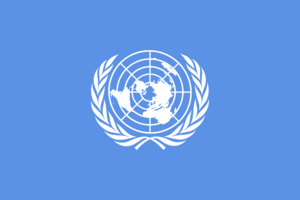Kyoto Protocol facts for kids
| Kyoto Protocol to the United Nations Framework Convention on Climate Change | |
|---|---|
 |
|
| Signed | 11 December 1997 |
| Location | Kyoto, Japan |
| Effective | 16 February 2005 |
| Condition | Ratification by at least 55 states to the Convention |
| Expiration | In force (first commitment period expired 31 December 2012) |
| Signatories | 84 |
| Depositary | Secretary-General of the United Nations |
| Languages | Arabic, Mandarin, English, French, Russian, and Spanish |
The Kyoto Protocol is an important international treaty. It builds on an earlier agreement from 1992 called the United Nations Framework Convention on Climate Change (UNFCCC). The main goal of the Kyoto Protocol is to get countries to reduce the amount of greenhouse gases they release into the air.
Scientists agree that our planet is getting warmer. This is known as global warming. They also agree that a big reason for this warming is the CO2 emissions that humans create. The Kyoto Protocol was created to help deal with this problem.
It was officially adopted in Kyoto, Japan, on December 11, 1997. The agreement then became active on February 16, 2005. Today, 192 countries are part of the Protocol. However, Canada decided to leave the agreement in December 2012.
Contents
What is the Kyoto Protocol?
The Kyoto Protocol's main aim is to slow down global warming. It does this by trying to lower the amount of greenhouse gases in our atmosphere. The goal is to reach a level where these gases no longer cause dangerous changes to our climate.
Gases Covered by the Protocol
The Protocol focuses on six main greenhouse gases. These are gases that trap heat in the Earth's atmosphere. They include:
- Carbon dioxide (CO2)
- Methane (CH4)
- Nitrous oxide (N2O)
- Hydrofluorocarbons (HFCs)
- Perfluorocarbons (PFCs)
- Sulphur hexafluoride (SF6)
Who is Responsible?
The Protocol understands that not all countries can fight climate change in the same way. This is because countries have different levels of economic development. So, the Kyoto Protocol places a bigger responsibility on developed countries. This is because these countries have historically produced more greenhouse gases. They are largely responsible for the current high levels of these gases in the atmosphere.
Commitment Periods
The Kyoto Protocol set specific times for countries to meet their goals.
First Commitment Period
The first period for countries to reduce their emissions started in 2008. It ended in 2012.
Second Commitment Period
A second period was agreed upon in 2012. This is known as the Doha Amendment to the Kyoto Protocol. In this period, 37 countries have specific targets they must meet.
Future Plans
Discussions have been held each year at the UNFCCC Climate Change Conferences. These talks are about what actions should be taken after the second commitment period ends in 2020.
Images for kids
-
This image shows the countries that had greenhouse gas reduction targets for the first period (2008–2012). It also shows how much their carbon dioxide emissions from burning fuel changed between 1990 and 2009. You can find more details about specific countries and regions at Kyoto Protocol and government action.
See also
 In Spanish: Protocolo de Kioto para niños
In Spanish: Protocolo de Kioto para niños


